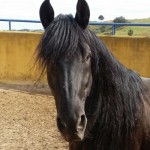 His glance is quick but sustained, if only momentarily, before he turns his head away dismissively, returning to his quest for companionship. The wall is high. He raises his muzzle to crest it. His neck strains. His back hollows. Where are the other horses? What little muscle he has left quivers under his smooth black coat. Then, sensing my continued presence, he whips his head around, as if to challenge me. Is there really a demon in his eye? He lunges towards me, his gait surprisingly rapid, with only a hint of shuffle belying the presence of his deformity. Then he is here, filling the space before me with a presence that is infinitely larger than his withered body. Yet his eye is bold, alert, curious. There is no sign of malicious intent, no need for any in those who know no fear. What a magnificent stallion he once must have been.
His glance is quick but sustained, if only momentarily, before he turns his head away dismissively, returning to his quest for companionship. The wall is high. He raises his muzzle to crest it. His neck strains. His back hollows. Where are the other horses? What little muscle he has left quivers under his smooth black coat. Then, sensing my continued presence, he whips his head around, as if to challenge me. Is there really a demon in his eye? He lunges towards me, his gait surprisingly rapid, with only a hint of shuffle belying the presence of his deformity. Then he is here, filling the space before me with a presence that is infinitely larger than his withered body. Yet his eye is bold, alert, curious. There is no sign of malicious intent, no need for any in those who know no fear. What a magnificent stallion he once must have been.
Shadow without submission
Now he is but a shadow of the stunning black beast who surely used to capture admiring glances wherever he strutted. Now there is little more than a collection of sunken withers, protruding ribs, hollow flanks and jutting hips. And below to the rear and right, he wields the club of his misshapen foot like a heavy farming implement that is no longer fit for purpose. A lesser horse might have given up, lain down, heaved his last breath. Not this one.
The spirit of the black stallion knows no submission. He seeks the horses in the paddocks bordering the high concrete perimeter of the longeing yard into which he is turned out each day when the weather permits, which is fortunately almost always. When he tires of searching, he waits patiently until they come. And some do and their visits are heralded, celebrated and saluted with all the fire and energy that the imprisoned creature can muster. Yet the visits are far and few between. In the evening he is returned to his stable, which is fortunately large enough for him to take a good few steps and turn around.
By local standards the black stallion is doing well, especially for a rescue horse. So I am told, and the comparative material I have seen with my own eyes in the form of row upon row of physically splendid and psychologically abused stallions cooped up in tiny boxes every waking day affirms this. And yet, when I see him fretting at the door of his stable or dragging his deformity while anxiously pacing, I cannot but wonder whether he is not the epitome of the huge dilemma facing all who have anything to do with rescuing creatures such as this: are we saving horses or are we recycling abuse?
Live or die
Andalusia, home to the magnificent breed of horses bearing its name and sold to the world as pura raza español (PRE) is also home to a number of equine rescue centres. Although the abuse of horses is probably as common in Andalusia as it is in most parts of the world where it masquerades as conventional horse husbandry, there is an added dimension to it here. The socio-economic crisis which has laid the region low for some time now has also dramatically increased the number of horses that are suffering through neglect or impoverishment, if not downright cruelty.
Well-meaning humans, almost all non-Andalusian, have come to the horses’ aid. Tirelessly they give of their time, energy and earnings to provide as much care as possible to as many equines as possible, virtually refusing to entertain the possibility that not all horses can or should be saved and with such realisation the challenge of playing god. For if you accept that possibility, then surely you will inevitably find yourself called upon to decide whether a horse can be rescued or not, in short, whether it is to live or die.
The weak and the strong
In late February 2015 Vicki and I visited Los Caballos Luna (a.k.a. for our Dutch readers Paard in Nood Spanje) at their former headquarters outside Bocairent about an hour south-west of Valencia, Spain. During our stay we carried out an Equine Touch session with, amongst other horses, a 16-month-old black mare called Abalia. In my post entitled Finding Strength through Weakness, I wrote this about Abalia:
“Although her skin was flaky in places, mainly through the mane and on her croup, she struck me as being brazenly resilient. Unfortunately, she was confined to a dark, windowless enclosure to provide support for her six-month-old sister, Utopia, a fragile filly whom we were asked to help. Vicki and I looked at each other and both of us immediately realised that we were being asked to help a horse that would be dead very soon. While every cell of my being bled tears for the tiny, emaciated body before me, they cried loud and clear for her suffering to be terminated and her sister to be released into the light. Sadly, I remained silent, even when apprised of the latest nocturnal events to keep the poor creature alive. Soon after our return to the Netherlands, we learned that Utopia had died within 48 hours of departure. I shed a brief tear for her before celebrating Abalia’s liberation.”
Looking back on this experience now, I realise that it represents just another aspect of the same dilemma. Should anyone who really cares for horses to the extent that they are prepared to sacrifice their own comfort to help them – and there are many who do including the owner of the livery yard business where our mares are currently kept – try and save every horse even if it means stretching resources so greatly that even those who could be saved have their health and wellbeing seriously compromised due to overreach? Put another way, if we try to save those horses whom we know have very little chance of surviving, do we not risk jeopardising the survival chances of those horses who are in such good condition that they are quite likely to not only survive but also thrive provided that there are enough resources for them to do so?
Re-homed and re-rescued
Vicki and I have just returned from performing Equine Touch sessions for a couple of horses at one of the local rescue centres. One of them is a very special mare called Velada, a six-year-old grey mare who is covered with melanoma and other non-cancerous (so we are told) growths. This is the second time that I have shared an Equine Touch session with Velada, the first being a little over a week ago, a session which I must confess was the most intense that I have experienced with a horse and which reduced me to tears.
What is so utterly special about Velada is her vulnerability coupled with an unbelievably courageous spirit. This sensitive mare has been in this rescue centre before, where she received the care she required . Some eight months ago she was rehomed to what I am told was a trekking centre. Several weeks ago she was returned to the rescue centre with a comment to the effect that perhaps she does not like humans, as she was not particularly cooperative with our species.
It did not take Vicki or myself very long to establish the causes of what would probably explain the source of that comment. First of all, some of the growths on the mare were in places which would probably cause her great discomfort or pain if she were ridden, and especially if that occurred as frequently as it might in a trekking centre. In particular, Velada, had large growths covering the parotid glands between the jawbone and the neck. It did not take much imagination to realise that if her head were pulled towards her body, she would experience great discomfort, if not pain. Secondly, the mare is underweight. Trekking makes huge demands of a horse, clearly far in excess of what she is capable of. Thirdly, there are marks on her back which suggest that a badly fitting saddle could also have played a major role in inducing Velada to resist human advances.
What I found particularly painful though, was to learn from the head of the rescue centre that Velada had tossed a rider off twice since returning to the centre. Just read that sentence again within the context which I have described and you may realise that we are dealing with yet another difficulty besetting the horse rescue endeavours of sincere, well-meaning humans. Yes, the mare is kept in a small yard. Yes, this means that she requires regular exercise. Yes, this means that she must be ridden? Yes, this means that the rider must be someone with whom she has little or no connection? Is it ignorance? Are these good intentions gone crazy? Are we saving horses or are we recycling abuse?
These questions took on added significance today when I realised that, of the four horses currently in the main refuge centre stables, three are being “re-rescued” after being “re-homed”. And one of them has been “re-homed” and “re-rescued” more than once. Are good intentions enough?
Good intentions, harsh reality
The reality of the horse is harsh, as is that of the majority of the world’s humans. It has always been so. In the wild nature is not always as romantically blissful as we often care to believe or hope. Like humans, nature is as capable of creating the most heart-warming beauty as it is of wreaking the most gut-wrenching horror.
In captivity the situation of the horse is no less dire. Indeed, it is arguably worse, even in places boasting part of the world’s most advanced horse care environment, such as the United States of America, Britain, the Netherlands and Germany. We humans do our utmost to create conditions of despair for our horses and we start well before they are born. Breeding is unbridled and geared towards meeting human aspirations rather than satisfying equine requirements. I could go on to decry the way we raise horses, how we keep them, how we…. Ultimately though, it would help neither us nor the horse.
Good intentions, harmful outcome?
So what of good intentions? If they are not enough, can they also be downright harmful? Let us first take a contemporary example to illustrate the difficulty. During the first decade of this century extensive campaigning by horse lovers came close to outlawing horse slaughter in the United States of America. Although the bill never became law, the few horse slaughterhouses left in the country closed for various reasons, one of the main one’s being the federal government’s refusal to release funds to finance mandatory inspections. As a result the slaughter of horses has been effectively halted in the USA.
Horse transport in the United States of America
Instead of horses being slaughtered in local abattoirs in the country, where they could ultimately be better regulated and supervised in response to growing and increasingly vociferous public concern, they are now transported alive (the term is used advisedly to refer to nothing more than the condition of being not dead) over vast distances to abattoirs in Canada and Mexico, where standards are not much better than they were in the US slaughterhouses before they closed, and are arguably worse especially south of the border.
In addition, the massive increase in the widespread transport of horses to slaughter following the closure of the US abattoirs has been accompanied by documented evidence of systematic abuse throughout the entire “supply” chain. Most of the evidence is graphic and challenging, as revealed in the videos accompanying this post and the documents available through the following links:
- https://en.wikipedia.org/wiki/Horse_slaughter
- http://www.animalsangels.org/images/stories/pdf/animals_angels_horse_slaughter_compilation_report_-_full_version.pdf
- http://www.animalsangels.org/files/images/stories/pdf/Animals’%20Angels%20horse%20slaughter%20compilation%20report%20-%20short%20paper-edited.pdf
While there is ample evidence to suggest that widespread cruelty also occurred in US slaughterhouses while they were still operating, there is more than enough to sustain the conclusion that the current situation is worse.
The horses and the humans
Of the 30 or so horses with whom our mares share a large field, the majority are to all intents and purposes rescue horses. There are far too many horses in this field even though it is huge by Western European standards. The horses have inadequate shelter for the winter rains and the summer sun. And they move over terrain of soft earth pocked with rocks and stones, the result being relatively soft hooves chipping easily. Age-old manure still litters much of the field, the stones rendering it difficult if not impossible to remove. And then there are the injuries which inevitably occur when horses have to move quickly to avoid each other over potentially dangerous terrain, three that I know of in the past week, our mares being two of them. Fortunately, the injuries have been relatively minor. Yes, these are issues that can be remedied. No, there is no ready money to fund all that needs to be done. And until recently, the managers who have been hired to do the job have been unable to do so for some reason or another.
And yet there are glimmers of hope and they all start with the human and not the horse. Most of the owners of the horses in the herd have managed to clear the stones from quite a large section of the field, making it easier for them and others to remove the manure and to feed the horses in areas where none covers the ground. Access to the few shelters available has been improved and made safer. Some horses have left for new pastures, reducing the congestion in the field somewhat. A new manager who, by all accounts and from what I have seen so far, is committed to improving the wellbeing of the horses, is taking over as of the beginning of the second quarter. She also has experience of equi-sharing, a scheme to share responsibility for a horse amongst several humans, thereby providing for the horse while reducing the burden for the human, one which she hopes to introduce here for the numerous rescue horses that require more care.
Of course there will be challenges. Finding money to fund additional shelters will be one of them. In addition, many of the horses that will become part of the equi-sharing scheme will need to have their feet tended to regularly and will require some assistance before they are safe for close contact with humans. Then there is the question of just where such humans will come from, as most of those involved with horses in this part of the world prefer a conventional horse care regime. And those that are drawn toward a more horse-friendly approach will require assistance and training. Although there have been difficulties in the past, there is great potential here for horses and humans. May it become reality.
The black stallion
But what of the black stallion heaving his deformity around the longeing yard? The other day there were blood stains on the concrete leading from it to his stable, as though he had scuffed his twisted foot raw. He was confined to his stable for the day but is now well enough to resume his daily routine. Out into the sand circle during the day, into the stable at night, day after day, sometimes he has visitors, mostly he has none.
Is this a life? Is it not better than his former life? And the fire of the stallion that bursts into flame now and then, however subdued it may be compared with his former self, is it not testimony to his indefatigable spirit and will to live? Or is it a cry of anguish?
Care to play god? I look back on the animals, all so dear to us, that Vicki and I have chosen to kill. Yes, it was euthanasia and yes, we were convinced that it was the best thing to do in the circumstances. Four cats and four dogs, all euthanised. Ultimately though, on each occasion we put an end to a life. We killed. The spade is a spade and not a shovel. And time and time again, we subsequently asked ourselves the questions that continued to haunt us. Did we act too soon? Did we leave it too late? Should we have…? Until the horse taught us that there is no point in living in the past.
So to the present. Is the black stallion asking us a question? If he is, what is that question? And if that question is then multiplied to cover all the equines in need, what would they be asking us? Would it be this: Are we humans saving horses or recycling abuse? Who dares to answer?
Horses and Humans on Facebook
May I remind you that we now have a Horses and Humans group on Facebook. If you would like to leave a comment, you can do so on this blog or on the the Horses and Humans Facebook group page. All new posts will feature on that page along with additional content posted by any of our members. Please feel free to join us at:
https://www.facebook.com/groups/horsesandhumans/
There is also a Horses and Humans publications page, which contains information concerning the publications released under the Horses and Humans imprint. Some of those publications will be free of charge. You will find it here:
https://www.facebook.com/horsesandhumans
I also have a Facebook page through which you may contact me. You will find it at:
https://www.facebook.com/andrewglynsmail
Equine Touch
Our Equine Touch business is called Humans for Horses, you can find our website at:
http://www.humansforhorses.com/
and our Facebook page at:
https://www.facebook.com/Humans.for.Horses
CLARIFICATION
Since this post was published, three of the comments that have appeared have been removed. I have been asked to explain why. This is the reason for this clarification.
The first of the three comments was a highly critical response from Monica, the new manager of our livery yard. The second was a brief statement of support for her from a fellow livery yard client named Maria. The third was my response to Monica’s comment.
My response was the first comment to be deleted, as Vicki and I felt that the matter was best dealt with privately. Shortly afterwards Monica approached us and explained that she had read my post too quickly and had completely misinterpreted it as a result, assigning it a meaning completely opposite to that intended. She asked me to delete her comment and the matter has now been resolved.
Because Maria’s comment was essentially an expression of support for Monica’s post, I deleted it, contacted Maria and explained why.
The incident has been all the more unfortunate because, to the extent that Monica is committed to the wellbeing of the horse and her approach to horse care and horse-human interaction is similar to ours, she enjoys our support as the new manager.
—000—

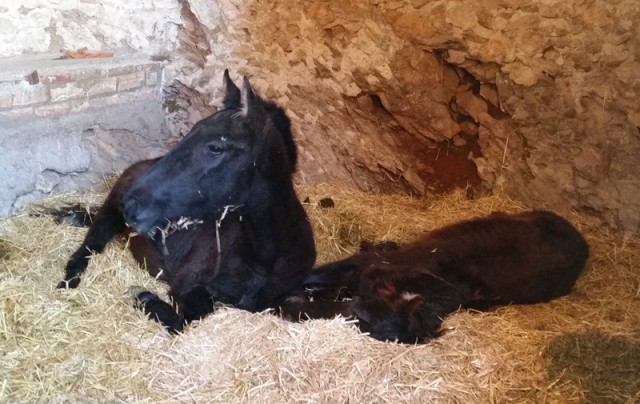
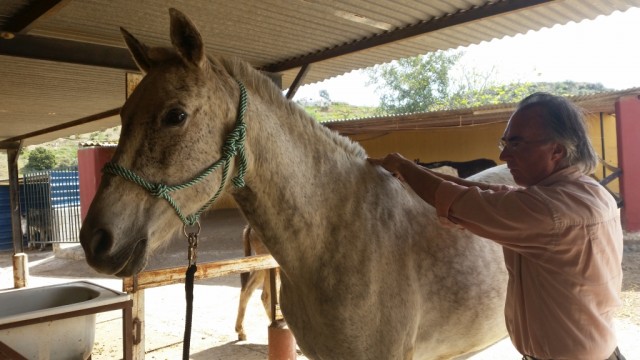
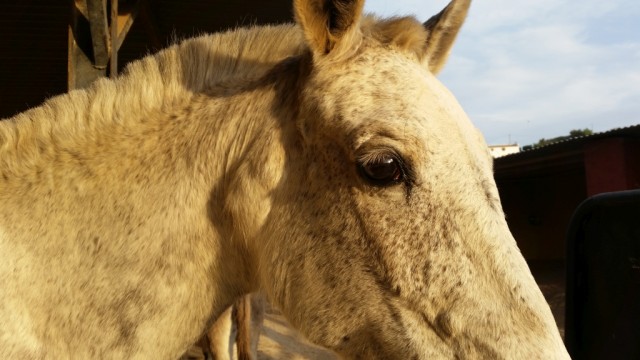

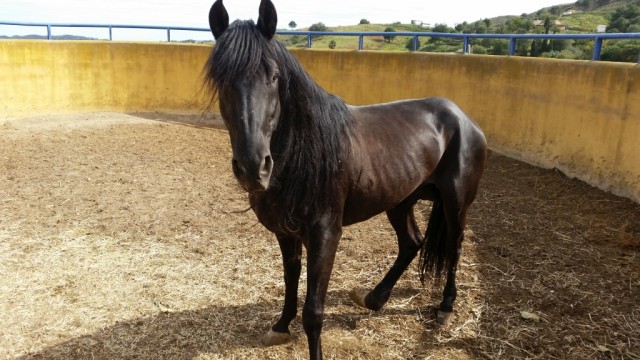



Great post & thank you! Currently, in my pasture I have an Arabian mare who a friend of mine rescued from slaughter. To think that this horse would be killed is horrific! She has the most friendly, curious, open hearted horse-onality; she’s a petite little chestnut with cute conformation and she is an excellent mover. She is bold, brave and likes children. She is alone right now, quarantined before she heads off to the other barn and the other horses(whereupon arriving surely we will see more of her true attributes!) & she is doing surprisingly well. When she arrived she wasn’t even that underweight. In short, she is an extremely nice horse who was pretty much about to be thrown out like garbage. Thankfully, my friend stepped in. We live in the US; purportedly, this horse was heading to Canada next.
The story of the stallion is pretty heartbreaking. Everyone needs a friend, a life, and horses are creatures of freedom. What to do about these conundrums. Surely, we must take excellent care of the horses in our lives, constantly seek to improve our horsemanship and keep our equine friends happy and engaged. If we have stallions or mares, any and all breeding should be responsible and ethical breeding. If this business is in our hands we should be doing it with love and compassion, not in the name of greed or exploitation. Caring for horses is actually a lifestyle choice, in my opinion, and it requires great dedication. Those of us who truly love horses know this.
Education, I suppose, is key. We must educate ourselves, then educate others. Surely there are levels of activism we can engage in: this same friend who rescued the Arab mare told me about mares who remain almost constantly pregnant in order to yield urine which is used by pharmaceutical companies to make some drug. (Note to self: research this.)
We must first deal with the horses in our lives, which will then send waves of positivity out and to others. The personal is the political, after all. Secondly, what’s good for horses is also good for humans, so we need to be keep the land alive! Wild places for animals who will always be wild at heart. No more developing!!!
Also beware of the “rescuer.” Those of us who know horses know that they are not all suited for the same thing. Like the gray mare u speak of: education! Clearer guidelines for what a horse may or may not be suitable for. Really, the lot of the issue come down to completely changing some long held notions about how humans and horses interact. The horse exists for the human to “use”, right? Wrong. They are not better (well, OK: sometimes they are way better than us, they do not lie, cheat or steal or over think things) or worse than us. They are one of god’s creatures too, and they deserve a right to “life, liberty & the pursuit of happiness.” They are beings of the earth, wind, Sky. We are intelligent enough to learn how to partner with them amicably and often magically. To quote, I think, klaus hempfling, give to the horse and he will give back to you ten times over.
Some words all horse people should reflect upon: time, dedication, awareness, desire, focus, understanding, communication, innate, energy, empathy, love. That’s where I stand.
The drug she is referring to is Premarin ( pregnant mare urine ) it is a despicable industry that manufacturers this hormone replacement drug for women. It has been proven to be dangerous for women in a very famous study.
great subject Andrew! I often think the same…better to end the suffering and not prolong or exchange one suffering for another. All lessons and learning for us, pointing to our heart from the horse. One way or another they give to us mere humans! I lean on the side of euthanasia for whatever reasons of my own projections. In the moment though I would do what arises in my heart at that moment and try not to delve into mind created judgements or right or wrong.
Andrew, I just LOVE you… In fact, love is not strong enough a word… I need you in my life (no Vicky, don’t get upset, not in THAT way) 😉 What I mean is that the horse lovers need your wise thoughts, your insight, your facinating way of putting things in words that can be understood by some (wish I could say everyone but I think were far from that still). Thank you from the bottom of my heart and please continue, I am sure it’s not easy and you probably wonder why you put so much effort for so little pay off (I imagine) but I just wanted to let you know that maybe people don’t respond but I am sure many think the same way as I do. I don’t often comment on your posts but they always feed my reflexion and understandings. THANK YOU!
Dear Andrew,
Thank you so much for sharing such a story. For your honesty and directness, which is sadly lacking in so many cases where emotions become entangled with what is going on.
For me, this proud sentient being who stands before you demands nothing more than that honesty you carry to him. He stands and asks what do you bring before me? And my sensing is whatever decision is made, as long as it is made within that same stream of honesty, will be OK with him. He feels no need to lay blame at anyone’s door, for life is as it is; he just asks for someone to look him directly into his eyes and tell him what is to be. And it will be OK.
Pleasing to read some thoughtful words relative to the care, rehabilitation and maintenance of the horse named Amapolo.